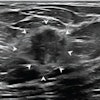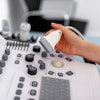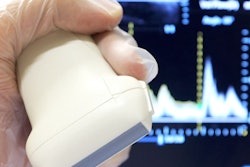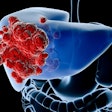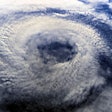
Ultrasound is a unique imaging modality due to the variability of image acquisition. Unlike other modalities where images are acquired linearly with fixed slices in a predictable order, ultrasound requires flexibility and a unique skill set to obtain diagnostic images. Surgical bandages, overlying bowel gas, and anatomical variability all affect the quality of the study.
While other cross-sectional imaging provides a holistic view of the internal anatomy of a patient, ultrasound can be thought of as a flashlight interrogating a dark room. If an area isn't illuminated, it just isn't seen. As well, sonography is unique in that we give great latitude to the sonographer to select the images that appropriately illuminate and document the anatomy and pathology (usually within the confines of a protocol). To ensure that the interpreting physician has all of the necessary images to render a diagnosis requires appropriate documentation.
 Dr. Roy Filly.
Dr. Roy Filly.Skilled sonographers are adept at obtaining diagnostic images under even the most challenging conditions, but the variability inherent in ultrasound scanning poses a challenge for the interpreting physician.
One of the major advantages of sonography is its real-time capability. There are only a few options available for the physician to gather this highly useful information. When real-time sonography became available, supplanting articulated-arm B-scanners, the diagnostician needed to scan patient in real-time after the sonographer had gathered images. Alternatively, the study could be recorded on videotape.
Neither of these solutions was satisfactory for physicians in busy practices. It was impractical to perform "dual" examinations on all patients (i.e., the sonographer examines first and records static images followed by an abbreviated real-time examination by the physician). It was equally time-consuming to review videotapes of the entire examination performed by the sonographer. The solution came with the ability to capture short, digital dynamic clips.
A critical tool in physician-sonographer communication
Thus, one of the most important tools available to the sonographer is the ability to capture dynamic clips in the course of the exam. In concert with static images and Doppler interrogation, a more complete display of the study can be presented while keeping the static images to a manageable number.
Sonographer efficiency is highest when an area of interest is documented quickly and accurately. Attempting to capture a real-time examination with static images alone is error-prone. It often results in the radiologist needing to accept the verbal information provided by the sonographer with no supporting documentation.
Dynamic clips are critical documentation in a wide variety of areas:
- Difficult-to-visualize structures are easier to see in motion when the patient body habitus impacts image quality.
- Surrounding structures help pinpoint the area of interrogation when alternate scanning windows are employed due to bandages, patient positions, situs variations, etc.
- A single sweep can convey overall invasiveness of a process, such as liver metastases, much faster than multiple individual static images.
- A clip of abnormal hepatic blood flow using color Doppler imaging is faster and more accurate than trying to time the capture of static images, or getting an artifact-free spectral Doppler tracing.
- Aortic aneurysm blood flow and isolation of renal arteries is faster and more accurately documented with a dynamic clip.
- Valves in venous structures, collapse of venous walls under compression, and the "blinking light" of arterial flow in a transverse scan of the calf are all faster and more accurate when clips are used versus static images.
- Complex structures such as neonatal heads are better viewed using a dynamic clip when a holistic view is required.
- Uncontrolled patient movement (pediatrics, Parkinson's disease, dementia, and patients in severe pain) can make static images suboptimal, but the dynamic nature of clips ensures clearer study documentation.
Another often-overlooked benefit of the use of clips is the reduced stress on the sonographer. Repetitive stress disorders are a growing problem, resulting in the most experienced and skilled sonographers leaving the profession. A single quality clip can be obtained in a fraction of the time and with much less mechanical stress than what's needed for a series of static images.
In my opinion, dynamic clips are the solution to a host of sonographic imaging problems. Sonography is a challenging diagnostic pursuit under the best of circumstances. Due to technical problems, "the best of circumstances" usually do not pertain. Trying to interpret sonograms without dynamic clips is tantamount to attempting to be a diagnostic sonologist with one hand tied behind your back. Do not limit yourself by failing to record dynamic clips.
Looking ahead: The future is dynamic
The current workflow barrier to utilizing clips in ultrasound can be addressed today by software that integrates with existing PACS workstations. This critical integration addresses the need to use PACS for other modality viewing while restoring ultrasound clips to routine use, without the need for manual intervention, every time viewing a clip in PACS is necessary.
This fundamental and important functionality is going to increase dramatically with the imminent U.S. Food and Drug Administration (FDA) approval of contrast-enhanced ultrasound (CEUS) agents in radiology. The need for routine and automatic display of clips in the context of static images is critical for diagnosing and documenting a CEUS exam. A complete contrast cycle (from injection, to maximum fill, to outflow) can be several minutes in length. While bookmark tools remove the need to view the entire clip for diagnosis, the need to document and display the entire clip when needed is still required.
The clinical importance of ultrasound clips is well-established. Since it was first offered with great success 25 years ago, the industry has gradually accepted compromises in ultrasound exam interpretation in recent years. This state of affairs is not sustainable in the new healthcare environment of reduced reimbursement, greater patient throughput, larger and more difficult to image patients, and contrast-enhanced ultrasound.
Dr. Roy Filly is an emeritus professor of radiology, obstetrics, gynecology, and reproductive sciences at the University of California, San Francisco.
The comments and observations expressed herein do not necessarily reflect the opinions of AuntMinnie.com.


